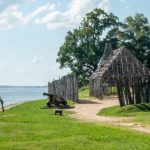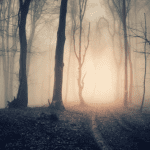 Weird Stuff
Weird Stuff  Weird Stuff
Weird Stuff  Our World
Our World 10 Ways Your Christmas Tree Is More Lit Than You Think
 Movies and TV
Movies and TV The 10 Coolest Stars to Set Sail on The Love Boat
 History
History 10 Things You Didn’t Know About the American National Anthem
 Technology
Technology Top 10 Everyday Tech Buzzwords That Hide a Darker Past
 Humans
Humans 10 Everyday Human Behaviors That Are Actually Survival Instincts
 Animals
Animals 10 Animals That Humiliated and Harmed Historical Leaders
 History
History 10 Most Influential Protests in Modern History
 Creepy
Creepy 10 More Representations of Death from Myth, Legend, and Folktale
 Technology
Technology 10 Scientific Breakthroughs of 2025 That’ll Change Everything
 Weird Stuff
Weird Stuff Ten Bizarre Facts About The Doge Meme
 Our World
Our World 10 Ways Your Christmas Tree Is More Lit Than You Think
 Movies and TV
Movies and TV The 10 Coolest Stars to Set Sail on The Love Boat
Who's Behind Listverse?

Jamie Frater
Head Editor
Jamie founded Listverse due to an insatiable desire to share fascinating, obscure, and bizarre facts. He has been a guest speaker on numerous national radio and television stations and is a five time published author.
More About Us History
History 10 Things You Didn’t Know About the American National Anthem
 Technology
Technology Top 10 Everyday Tech Buzzwords That Hide a Darker Past
 Humans
Humans 10 Everyday Human Behaviors That Are Actually Survival Instincts
 Animals
Animals 10 Animals That Humiliated and Harmed Historical Leaders
 History
History 10 Most Influential Protests in Modern History
 Creepy
Creepy 10 More Representations of Death from Myth, Legend, and Folktale
 Technology
Technology 10 Scientific Breakthroughs of 2025 That’ll Change Everything
10 Super Unsettling Finds Dug Up at the Jamestown Colony
Jamestown, Virginia, is a pretty cool place. After all, it was the first permanent English settlement ever established in the New World. And since it was first settled in 1607, it has some pretty incredible history tied to it. The very founding of the United States of America links all the way back to Jamestown. The first English speakers to ever call our continent home put down their roots there. Today, families still boast about being direct descendants of those folks. Patriotic and pride-inducing, right?
But Jamestown has a creepy side, too. Like any place with enough history in it, weird and eerie things were pretty much bound to happen there. And they did. In this list, we’ll go over ten of the most unsettling and scary finds ever found at the Jamestown Colony. Archaeologists recoiled in horror at finding some of this skin-crawling evidence of humans who lived more than four centuries ago. Read on if you can stomach learning all about it.
Related: 10 Facts that Make The Roanoke Colony Even More Mysterious
10 A Truly Brutal Murder
One of the most unsettling discoveries by archaeologists at Jamestown was that of a 14- or 15-year-old boy. The teen had an Indian arrowhead buried deep in the bone of his left leg. Right there, that made experts assume that he’d been murdered during some kind of altercation or battle.
Skirmishes between the white settlers and the Powhatan tribe members, unfortunately, weren’t uncommon. But what made the situation so sad—and so unnerving—was that the boy’s burial almost certainly happened very, very early after the Europeans arrived in 1607. Some experts think he might have been killed within days of the group first making landfall.
Part of the reason why experts think that is because the boy was hastily buried. Historians think that based on the position of his body and the fact that the dirt covering him was both shallow and completely lacking in any European burial artifacts or grave memorials. Clearly, the settlers felt like they had to bury him very quickly after their arrival and his near-immediate death.
It’s likely that they were so shell-shocked over whatever attack, skirmish, or battle had occurred that they didn’t feel like they had the time to mourn properly. Both Captain John Smith and Captain Gabriel Archer wrote that a young boy had been murdered. But sadly, the boy’s name, identity, and specific backstory will never be known.[1]
9 Full Military Honors
In addition to that young boy cut down too soon, four early Jamestown settlers were buried with full military honors in a grave discovered more than four centuries later. The grave was not only inside what used to be the old church, but it was in such a special spot within the sanctuary that archaeologists were certain that the men buried there were of great importance. Sure enough, DNA testing on the long-dead remains confirmed the identities of the men laid to rest there, and all four were notable.
The first three were Captain Gabriel Archer, Sir Ferdinando Wainman, and Reverend Robert Hunt. But it was the fourth burial that still breaks hearts today. The fourth dead man was Captain William West. He was only 24 years old when he died. He was killed during another skirmish with the Powhatan, this one coming in 1610.
Clearly, he meant a lot to the colonists because he was buried while wearing an ornate, fringed military sash. Much of it had disintegrated and fallen apart over four centuries, of course, but based on what remained, experts assumed that the garment was probably a costly silk piece of clothing with a silver fringe and spangles. That he was buried in such a way suggested in no uncertain terms that he was critically important to the colony. Seeing him die at the hands of a foe in battle could not have been easy for the notably few and relatively helpless people who were there trying to make it in the New World.[2]
8 A Knight’s Tomb
Speaking of graves unearthed at Jamestown, one of the strangest ones was a tomb belonging to a knight. Yes, you read that right. Sure, the Jamestown colony didn’t exactly kick off too far after the Middle Ages. But a knight’s tomb? Really? The confusion is deep on this one, too. For one, no one is quite sure of the identity of the knight. Lord de la Warr (yes, for whom the state is named) held that title, but that’s not him buried in the tomb. Historians know that much. Beyond that, there just isn’t much else to go on.
Sir George Yeardley had also been knighted in his life, even going so far as to make a difficult return trip to England to receive his knighthood after first becoming governor of the colony. He may be buried in the tomb, as in written records unearthed centuries after the fact, his family mentions wanting George buried in a black marble tomb. They were hoping for the man’s official crest to be slapped onto it, too. There’s no crest on the tomb today, though. So either it fell off at some point (and/or was stolen), or the knight buried inside isn’t actually Sir George at all.
The most vexing (and unsettling) part of it all is that we’ll probably never actually know who was buried there beyond broad assumptions. It could very well be Yeardley, which would at least be a bit of an easy solution for this mystery. But what if it isn’t? What if there was another knight roaming around Jamestown that we don’t know a thing about? It’s crazy how modern society can use DNA evidence, as discussed above, to confirm the identities of the remains of folks buried four centuries ago yet also be so far in the dark on other old burials just across town…[3]
7 A Terrible Family Scandal
As investigators have continued to dig (literally) into the remains left behind at Jamestown, they have also uncovered something truly shameful: an incestuous family scandal centering on an illegitimate child. The case was that of Thomas West, who became Jamestown’s leader three years after the group arrived in 1610.
West had been joined there by three brothers, along with several other male relatives. We know that now because DNA evidence from skeletons left behind in unmarked graves at Jamestown’s church reveals that at least two dead bodies there were related to West. Specifically, the two men were also linked by a shared maternal lineage. That confused investigators, and they dug a little bit deeper.
Eventually, historians uncovered documents that revealed one of the men—Captain William West—was the illegitimate son of Thomas. They know this because they have found definitive proof that William’s mother was actually Thomass’ aunt, Elizabeth. Yes, you read that right. While the younger West was regarded as being part of a very high-status family in England, his scandalous birth would have been such a terrible thing at the time that it could have been the impetus for the West family to flee the old world and come to Jamestown in the first place.
Captain William West went on to be very well-regarded in Jamestown, too. And, of course, his father led the colony for a while and was clearly one of the most powerful (and important) men in the New World at the turn of the 17th century. But even so, lingering whispers of William’s dubious parentage likely pushed the West family to hide the shameful secret for the rest of their lives. Oh, the unsettling tales that come out of even our most hallowed areas of ground.[4]
6 A Very Special Shakespearean Ring
One of the most precious (and mysterious) items to ever appear at Jamestown was a brass signet ring. Embossed with the image of an eagle with spread wings, the ring and its iconography were both associated with England’s powerful Strachey family. Indeed, William Strachey was an early Jamestown colonist. He had been a very educated man back in Europw. And he was so well connected that he actually moved within William Shakespeare’s literary circle during the early part of his life.
Strachey was also one of many passengers set out on a ship bound for Jamestown called the Sea Venture. Initially thought to be lost at sea on the way to the colony, the Sea Venture had actually just blown off course. It got caught in a hurricane and eventually landed in Bermuda. From there, it was put through repairs and eventually—on a much-delayed timetable—made its way up to Jamestown. Better late than never, right?
While there, Strachey and the rest of the passengers encountered something horrible: the so-called Starving Time. Named for one of the most challenging periods, which nearly wiped out all the colonists, the Jamestown newcomers were going through it. Strachey’s ship initially brought the colonists down the James River and into the Chesapeake Bay with the intention of going back home. But by then, the colonists had decided to take a second crack at actually settling Jamestown as a long-term location. So, they did.
Strachey stayed in Jamestown along with the other colonists for a while and tried to make a go of it himself. Eventually, though, he returned to England. There, it was said that he regaled none other than Shakespeare himself with tales of the New World and his nearly ill-fated trip west on the Sea Venture. Shakespeare, in turn, is said to have based his play The Tempest directly on Strachey’s experiences sailing to Jamestown. Pretty cool, right?
But here’s where things get sad and unsettling: Strachey’s (presumed) ring was found during an archaeological dig of the original Jamestown site. But Strachey himself lived long after his Jamestown foray, having returned to England to carry out the rest of his days. So it would seem that the Englishman lost his beloved ring—or had it stolen, or may have even sold it for virtually nothing—while in the New World. Obviously, he never got it back. Not in this life, at least.[5]
5 Bodies on Bodies
Not long after the first colonists settled down at Jamestown in 1607, the bodies began piling up—literally. Early records published by the Virginia Company show that the original colonists were asked to keep records of sickness, disease, and death away from the local indigenous peoples. That meant keeping all dead bodies firmly within the fort itself at Jamestown.
That was a new practice for English people, who typically did not live in close proximity to gravesites. It only took a few months for that entire situation to escalate to nearly uncontrollable rates of death, too. Over the first few months of the new colony’s existence in America, the graveyard filled extremely quickly.
The earliest written records from none other than John Smith himself indicate that more than 50 colonists died just in the period between May and September of 1607. Another several dozen died in the few months after that, too. In time, the rate of death and the amount of bodies that the surviving colonists needed to bury simply became too much to handle. So, they doubled up.
Archaeologists who have excavated the Jamestown Colony’s various sites in recent decades have found mass burial grounds that were within the boundaries of the old fort. In those burial sites, these experts also quickly discovered that many of the graves contained the remains of multiple people.
So, while Smith may have written that 50 colonists died in those earliest months, historians now believe it was quite a bit more. So many perished, in fact, that colonists had to shovel them into double graves after not having enough time to dig new holes for each deceased soul. Talk about grim.[6]
4 Baby’s Shoes, Never Worn…
Amazingly, a few pairs of shoes have survived the 400+ years since the Jamestown Colony was first settled in 1607. Horribly, at least one of those unearthed pairs of shoes came from a very, very young child. The shoes were made out of goatskin leather. And the condition in which archaeologists uncovered them four centuries later was of such high quality to suggest that they had barely been worn. Think about that: a child, a soul new to the world and ready to experience whatever may come from it, took his first-ever steps in the new settlement… and then died.
Beyond the obvious tragedy on that side of things, the baby’s shoes showing up at a gravesite further suggests that the child who died was one of means. Shoes were very hard to come by in a place like Jamestown. Sailors who set out with supplies for the colony would very often steal things like shoes on the voyage.
Others would smuggle and hoard shoes and other necessities for themselves. So, shoes soon became a mark of prestige. The fact that a child was buried in them would seem to suggest that the young person who perished there was one from a very high-status family with high expectations for a future that never came.[7]
3 The Most Profound Grave
The most profound grave to ever be discovered at Jamestown was that of four prominent early colonists. One of the four prominent souls buried there was a very young but precocious adult named Gabriel Archer. He was on the first voyage to Virginia, and he had a massive feud going on with Captain John Smith.
Here’s the wild part of it all, though: Archer’s grave actually contained a Catholic reliquary. That’s right! Even though Jamestown was mostly a Protestant place, Archer had surprising Catholic items with him in the new world. And CT scan technology put forth by modern-day archaeologists found something even more unsettling: there were shards of bones left inside that tiny Catholic grave box.
So, it’s time for a little bit of history: when Jamestown was established in 1607, England was a firmly Protestant country. Thus, English leaders were compelled to spread their Protestantism into the New World—especially as (very Catholic) Spain was doing the same thing. So the English Protestants pushed into Jamestown.
But why was the reliquary with Archer’s body? That part is completely uncertain. Could it suggest that he was a secret (or not-so-secret) Papist? Could it suggest that he had been trading with Spaniards? Also, whose bone shards were actually in that box—was it a piece of Archer or someone else entirely?[8]
2 A Cannibalized Skull
As if these things aren’t all creepy enough, let’s go with the most unsettling of them all: the cannibalized skull that was found amid the burial remains. The skull of an unidentified person contained visible cut marks on the preserved bones. That suggested that meat on the human head had been removed for human consumption—yes, cannibal activity. And that’s not the most unsettling part, too. It’s actually quite likely that Jamestown’s settlers would have engaged in cannibalism during at least one particularly tough point of their stay.
That was the period known today by archaeologists as “Starving Time,” and it happened at a point not long after the colonists settled at Jamestown in 1607. During the Starving Time, famine was relentless, and the population of the colony went from 500 people down to about 60 people. The “Starving Time” nickname was used very literally, and much of the population perished due to their simply not having enough food to eat. Things got so rough in Jamestown at that time that the colonists almost certainly would have had to engage in cannibalistic activity just to survive.
To make it even more morbid, archaeologists eventually named the cannibalized skull “Jane.” That’s because the skull and the bones found buried with it belonged to a teenage female who would have been around 14 years old when she perished. But at this point, it’s not clear if she was specifically murdered so that she could be eaten for food or if she died of starvation or disease and was then cut up and cooked up posthumously.
But while we’re being so morbid, let’s get just a touch deeper on the morbidity scale, shall we? During the Starving Time, one Jamestown colonist is said to have chopped up his pregnant wife and salted her dead body. Then, he supposedly cut the unborn baby out of her stomach and tossed it into the James River before proceeding to eat his wife for dinner again and again and again. Could that have been Jane?[9]
1 The World Beyond
Many goods from all around the world were brought to Jamestown in the first decade of the colony. Polish glassblowers were brought over in those first few years. So were German brass counterweights. Even though there were no Polish or German immigrants in the New World at that point, it didn’t matter. So much stuff came over with the colonists—and with later sailors who brought ships full of other things to the New World, too. Even back then, in many ways, the world was actually a really small place.
The German counterweight is a particularly cool (and confusing) item. It is a lion-shaped weight that dates back to the earliest days of the 17th century. Manufactured in Nuremberg, it was tiny—weighing just under 2 ounces (57 grams). And it wasn’t the only item from Nuremberg that was found at Jamestown by later archaeologist digs, either.
Also on scene at the old colony after more than 400 years was a trump mouthpiece. That also dates back to the early 17th century. At the time, Nuremberg was the place where that magic happened. So, again, the trumped mouthpiece would have had to have come from there. But why Jamestown? Why did the trumpet mouthpiece and the counterweight come over at all? After all, we’ve been learning that times were very, very hard in Jamestown during the earliest days.
Clearly, something was interested in playing the trumpet even as the world was falling and crumbling all around them. Beyond that, we’ll never know more about who it was, what their intentions were, and how they came to live in the near-disastrous experiment that was the English settling in the New World.[10]








